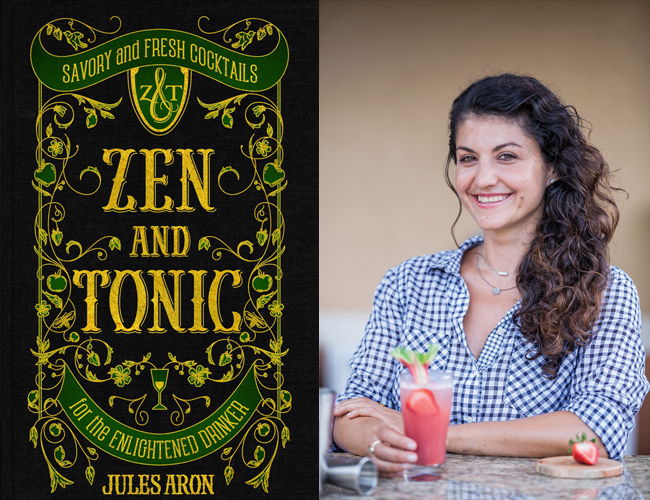When looking at a cocktail menu, do you find yourself wondering things like, “Are there a lot of antioxidants in this one? Good fats in that one?” No? Don’t worry, we don’t either—but that hasn’t dissuaded us from Jules Aron’s new cocktail book. “Zen and Tonic: Savory and Fresh Cocktails for the Enlightened Drinker” isn’t nearly as new-age or prescriptive as the title might suggest. Rather, it’s a starter cocktail cookbook for those who want their bars to reflect the local, organic and seasonal ethos that they maintain in their kitchens.
“Zen and Tonic” is not just a cute title; it’s Aron’s guiding philosophy (and also a beverage in the book made with rose-infused gin and aloe water, sweetened with blueberry lavender syrup, and topped off with elderflower tonic water). As the eponymous recipe, it works to embody the concept, defined in the introduction as “the healing art of the cocktail.” Aron wants to bring us back to the cocktail’s original application as a means of imbibing the medicinal properties of plants — florals, herbs, fresh fruits and natural sugars are the focus.
“Blossoming botanicals, medicinal bitters, flower waters, and herbal tonics have been prepared for centuries, laced in alcohol,” she tells me. “The concept is simple: avoid all processed sweeteners and artificial ingredients, and showcase botanicals and quality spirits.”
Aron doesn’t spend much time singing the joys of adding greenery to cocktails. The book begins with a useful primer on building your own home bar, from tools to glassware to spirits to ice. She includes a guide to widely available organic spirits, wines, sodas, and bitters, illustrating the ways in which you can stock a bar that’s as chock-full of quality ingredients as your pantry. Elaborate syrups like raspberry rose, a goji berry-infused vodka and flower-packed ice are explained in simple terms, useful even to a seasoned bartender who might be interested in bringing more fresh produce into their ingredient arsenal.
While it might be jarring to make good health an explicit purpose with one’s cocktails, the book proves repeatedly that it’s in search of the best quality — both of ingredient and of drink you’re swilling. Aron writes a brief note on moderation, making sure readers know that even when a drink is packed with chia seeds, no amount of superfoods can make overindulgence a virtue. But if you do go overboard, it’s probably better to do it on something like the Spring Fling — made with beets, kombucha and whiskey — than on anything packed with refined sugar. “By avoiding artificial additives, we can create full-flavored drinks without the need to compromise on pleasure,” she notes. “The days of the low-cal vodka seltzer are over.”
Right now is the time to be having this discussion, Aron believes. “The food culture — and healthy eating movement in particular — is the driving force for the resurgence of cocktail culture,” she says. “People are getting more concerned about the ingredients in their drinks, in the same way they have done with their food. They are very aware of what they are eating — how fresh the ingredients are, where they come from, how it’s grown — and are beginning to expect the same from their cocktails.”
If you want to banish refined sugar from your bar and get into raw, local honey, among other things, “Zen and Tonic” can be your guide.





